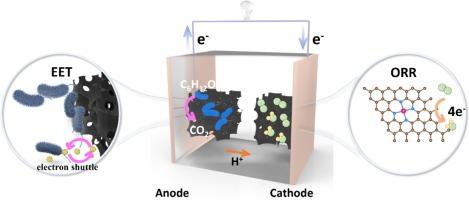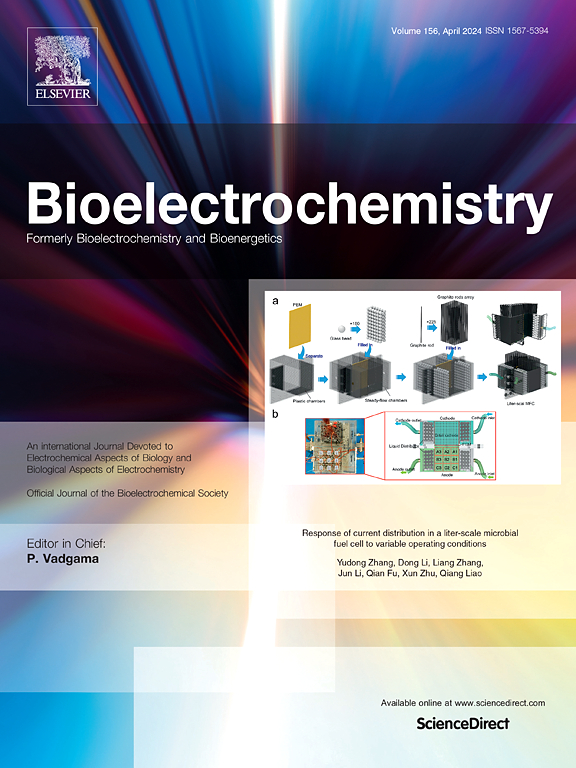Bifunctional electrode materials: Enhancing microbial fuel cell efficiency with 3D hierarchical porous Fe3O4/Fe-N-C structures
IF 4.8
2区 化学
Q1 BIOCHEMISTRY & MOLECULAR BIOLOGY
引用次数: 0
Abstract
The rational development of high-performance anode and cathode electrodes for microbial fuel cells (MFCs) is crucial for enhancing MFC performance. However, complex synthesis methods and single-performance electrode materials hinder their large-scale implementation. Here, three-dimensional hierarchical porous (3DHP) Fe3O4/Fe-N-C composites were prepared via the hard template method. Notably, Fe3O4/Fe-N-C-0.04-600 demonstrated uniformly dispersed Fe3O4 nanoparticles and abundant Fe-Nx and pyridinic nitrogen, showing excellent catalytic performance for oxygen reduction reaction (ORR) with a half-wave potential (E1/2) of 0.74 V (vs. RHE), surpassing Pt/C (0.66 V vs. RHE). Moreover, Fe3O4/Fe-N-C-0.04-600 demonstrated favorable biocompatibility as an anode material, enhancing anode biomass and extracellular electron transfer efficiency. Sequencing results confirmed its promotion of electrophilic microorganisms in the anode biofilm. MFCs employing Fe3O4/Fe-N-C-0.04-600 as both anode and cathode materials achieved a maximum power density of 831.8 ± 27.7 mW m−2, enduring operation for 38 days. This study presents a novel approach for rational MFC design, emphasizing bifunctional materials capable of serving as anode materials for microorganism growth and as cathode catalysts for ORR catalysis.

双功能电极材料:利用三维分层多孔 Fe3O4/Fe-N-C 结构提高微生物燃料电池效率
合理开发用于微生物燃料电池(MFC)的高性能阳极和阴极电极对于提高 MFC 性能至关重要。然而,复杂的合成方法和性能单一的电极材料阻碍了它们的大规模应用。本文通过硬模板法制备了三维分层多孔(3DHP)Fe3O4/Fe-N-C 复合材料。值得注意的是,Fe3O4/Fe-N-C-0.04-600 显示出均匀分散的 Fe3O4 纳米颗粒以及丰富的 Fe-Nx 和吡啶氮,在氧还原反应(ORR)中表现出优异的催化性能,其半波电位(E1/2)为 0.74 V(相对于 RHE),超过了 Pt/C(相对于 RHE 为 0.66 V)。此外,作为阳极材料,Fe3O4/Fe-N-C-0.04-600 表现出良好的生物相容性,提高了阳极生物量和细胞外电子转移效率。测序结果证实了它对阳极生物膜中亲电微生物的促进作用。采用 Fe3O4/Fe-N-C-0.04-600 作为阳极和阴极材料的 MFC 达到了 831.8 ± 27.7 mW m-2 的最大功率密度,可持续运行 38 天。本研究提出了一种合理设计 MFC 的新方法,强调双功能材料既可作为微生物生长的阳极材料,又可作为 ORR 催化的阴极催化剂。
本文章由计算机程序翻译,如有差异,请以英文原文为准。
求助全文
约1分钟内获得全文
求助全文
来源期刊

Bioelectrochemistry
生物-电化学
CiteScore
9.10
自引率
6.00%
发文量
238
审稿时长
38 days
期刊介绍:
An International Journal Devoted to Electrochemical Aspects of Biology and Biological Aspects of Electrochemistry
Bioelectrochemistry is an international journal devoted to electrochemical principles in biology and biological aspects of electrochemistry. It publishes experimental and theoretical papers dealing with the electrochemical aspects of:
• Electrified interfaces (electric double layers, adsorption, electron transfer, protein electrochemistry, basic principles of biosensors, biosensor interfaces and bio-nanosensor design and construction.
• Electric and magnetic field effects (field-dependent processes, field interactions with molecules, intramolecular field effects, sensory systems for electric and magnetic fields, molecular and cellular mechanisms)
• Bioenergetics and signal transduction (energy conversion, photosynthetic and visual membranes)
• Biomembranes and model membranes (thermodynamics and mechanics, membrane transport, electroporation, fusion and insertion)
• Electrochemical applications in medicine and biotechnology (drug delivery and gene transfer to cells and tissues, iontophoresis, skin electroporation, injury and repair).
• Organization and use of arrays in-vitro and in-vivo, including as part of feedback control.
• Electrochemical interrogation of biofilms as generated by microorganisms and tissue reaction associated with medical implants.
 求助内容:
求助内容: 应助结果提醒方式:
应助结果提醒方式:


